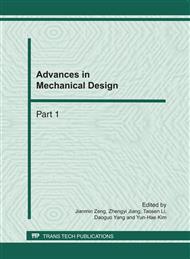p.318
p.323
p.329
p.337
p.341
p.348
p.354
p.358
p.365
Kinematics Analysis of the Wedge Clamping Device of PET Bottle Blowing Machines
Abstract:
In the current pin clamping device of bottle blowing machines, the design datum can’t coincide with mold datum. So it not only needs a pressure compensation device, but requires clamping holes to meet high precision. It makes the clamping device manufacturing and maintenance cost high. On the other hand, the producing plastic bottles have obvious mold lines. It affects products quality. For the above shortcomings, this paper designs a wedge clamping device, and then analyzes the kinematics modeling of planar moving cam mechanism and plane linkage mechanism. The results show that the device has smooth operation and small impact. So the new wedge device can meet the job requirements of high-speed rotary bottle blowing machines.
Info:
Periodical:
Pages:
341-347
Citation:
Online since:
February 2011
Authors:
Price:
Сopyright:
© 2011 Trans Tech Publications Ltd. All Rights Reserved
Share:
Citation:


